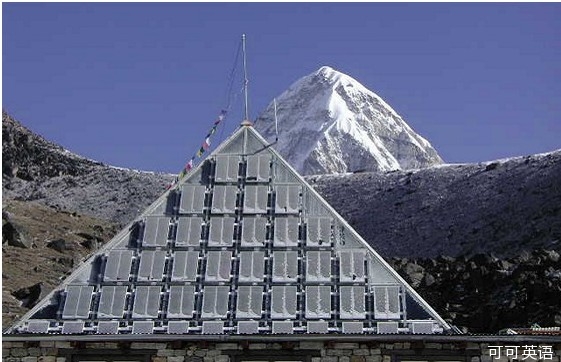
Science and Technology Pollution in the Himalayas Time to call the sweep?
科技 喜马拉雅山受到了污染 是时候呼吁清扫了吗?
Soot gets everywhere. Even into the world's highest mountains
到处都弥漫着烟灰,甚至蔓延到了世界的最高山。
THE Himalayas and the adjacent Tibetan plateau are sometimes referred to as the Earth's third pole, because of the amount of ice they host. They are also known as Asia's water tower. Their glaciers feed the continent's largest rivers—and those, in turn, sustain some 1.5 billion people. Many studies suggest, though, that the Himalayan glaciers have been shrinking over the past few decades. This has usually been attributed to rising air temperatures, but climate researchers have now come to realise that tiny airborne particles of soot and dust are also to blame. Being dark, they absorb sunlight. And that warms their surroundings.
喜马拉雅山及其邻近的青藏高原有时被称作是地球第三极,这是因为它们身上覆盖着大量的冰雪。有时也被称作亚洲水塔,它们所蕴藏的冰川是这片大陆中最大河流的水源,反过来这些河流维系着15亿人的生命。然而许多研究表明在过去的数十年里喜马拉雅山的冰川在不断地减少。这通常是由不断高升的气温所致,但是气候研究人员开始意识到这也归咎于空气中的烟灰粒子和尘埃,因为这些物质是黑色的,所以吸收阳光,进而使得周围气温升高。
Near cities, and in regions like South-East Asia, where people are clearing vegetation by burning it, soot is expected. But as Angela Marinoni of the Institute of Atmospheric Sciences and Climate in Bologna explained to an audience at the 2nd Third Pole Environment Workshop in Kathmandu on October 27th, the high Himalayas are also under an onslaught from this sort of pollution. Even at altitudes above 5,000 metres (16,400 feet), soot is widespread. And when it lands on glaciers it accelerates their melting.
在城市附近和像在东南亚这些地区,人们烧毁植被,因此就产生了烟灰。但是10月27日在加德满都举行的第二次第三极环境研讨会上,但是来自波隆纳的Angela Marinoni??—一位大气物理学及气候研究所的研究人员对一名观众解释到:"喜马拉雅山也受到了这种烟灰的污染".即使在海拔高于5000米(约16400英尺)的地区也弥漫着烟灰,当它们飘落到了冰川上,就会加速冰川的融化。
Dr Marinoni and her colleagues have been examining Himalayan soot since 2006. In that year the Nepal Climate Observatory - Pyramid, in the Khumbu valley, began a full-time study of aerosol particles, soot among them. The researchers' initial intention was to take advantage of what they assumed would be the pristine conditions found at such high altitude (the observatory is 5,079 metres above sea level) to measure typical background conditions of the atmosphere. Instead, they were surprised to find a thick haze, loaded with soot, smothering the mountain slope. In the rainless pre-monsoon months between January and May, about one day in five saw the Khumbu valley blanketed in a dense brown cloud.
自从2006年开始Dr Marinoni和他的同事就在调查研究喜马拉雅山上的烟灰。在那年,尼泊尔气象天文台—金字塔在孔布山谷开始专职研究浮质粒子中的烟灰。研究的初始目的是利用地处这片高纬度地区的原始地貌来测量大气中特殊的背景环境(天文台设在海拔5079米处)。然而他们惊讶的发现了一片充斥着烟尘的厚厚阴霾,笼罩着山坡。一月至五月是少雨的前季风时期,孔布山谷平均每五天中就有一天笼罩在厚厚的棕色烟云下。
By analysing atmospheric circulation patterns, Dr Marinoni and her colleagues found that winds could bring soot and dust from as far away as Europe, the Middle East and North Africa. And if that were not bad enough, the Himalayan valleys act as chimneys, pumping pollutants from the Indian plains to the mountain peaks. Dr Marinoni estimates that the combined effect of this crud could reduce the glaciers' ability to reflect light by 2-5% and increase the amount of melting by 12-34%.
通过分析大气循环类型,Dr Marinoni和他的同事发现风力可以把烟灰和尘土从远至欧洲,中东和北非等地带到喜马拉雅山上。如果这还不够糟糕的话,喜马拉雅山谷就犹如烟囱一样,把印度平原的污染物排放到喜马拉雅山峰。Dr Marinoni估计这种杂质的共同作用能使冰川的反光能力降低2-5%,融化范围增加12—34%。
Those suggestions are corroborated by a study led by Xu Baiqing of the Chinese Academy of Sciences' Institute of Tibetan Plateau Research, in Beijing. His team drilled cores from the ice of five Tibetan glaciers in order to examine the past few decades' worth of pollution. These cores show that the level of pollution, especially soot, in Himalayan glaciers correlates with emissions in Europe and South Asia.
中国科学院青藏高原研究所的徐柏青领导做了一项研究证实了以上研究人员的发现。他的研究小组钻取了青藏高原5大冰川的冰心以观察过去数十年的污染。这些冰心不仅表明了此地的污染程度,更重要的是说明了喜马拉雅山冰川上的烟灰与欧洲和南亚的排放相关。
In the north-west and centre of the Tibetan plateau Dr Xu and his team found that particularly high levels of soot had fallen on the glaciers during the 1950s. These regions are under the influence of westerly winds, suggesting that the soot in question originated in Europe. That hypothesis is supported by the observation that soot levels fell during the 1970s, a period when many European countries enacted clean-air regulations.
在青藏高原的西北部和中部地区徐博士和他的研究小组发现:在20世纪50年代大量的灰尘落在冰川上。这些地区受西风影响,因此研究人员正讨论这些烟灰可能来自于欧洲。一项调查报告证实了这个假设,报告表明20世纪70年代大量灰尘落到了喜马拉雅山冰川上,而且就在这一时期许多欧洲国家制定了净化空气的法规。
The glaciers in the south-eastern part of the plateau, by contrast, are downwind of the Indian subcontinent—and Dr Xu found that the concentration of soot in those glaciers went up by 30% between 1990 and 2003, coinciding with a period of rapid industrial growth in India.
相比之下,青藏高原东南部地区的冰川地处于印度次大陆的顺风处,徐柏青发现1990年至2003年间其地区的烟灰覆盖增长了30%,恰巧与印度这时期工业的迅速发展成正比。
The worry is not that the Himalayan glaciers will disappear. Despite a foolish mistake in a report by the International Panel on Climate Change suggesting that this might happen quickly, no one believes that to be the case. But accelerated melting induced by this soot could cause flooding. That would be bad enough.
人们所担忧的并非是喜马拉雅山冰川将会消失。尽管国际气候变化小组发布一项愚蠢的报告,表示在不久的将来可能会发生这一惨剧,但是没有人去相信。烟灰会加速冰川融化进而导致洪水的爆发。尽管这样,这也已经够遭的了。












